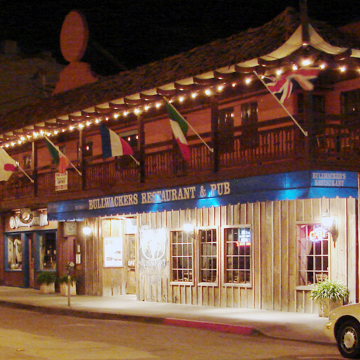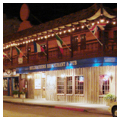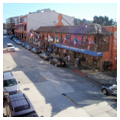You are here
Bear Flag Building
Immediately south of Steinbeck Plaza, on the inland side of Cannery Row, is the former Ocean View Hotel Annex, which business partners M.C. Wu and C.M. Sam erected in 1929 as an expansion of the main hotel, built on the bay side of the street in 1927. Its tiled, pagoda-like roof with flared eaves, exposed wooden rafter ends, light wells, and second-story wooden loggia are all architectural features that bespeak an Orientalist interpretation of traditional Chinese built forms. Its loose historicism is characteristic of the time period in which it was conceived, and its exoticism reflects the leisure industry’s reliance on such devices to tempt tourists.
By 1947, the building was known as the Venice Apartments, a name that alluded to its superficial Mediterranean Revival makeover: the entire exterior was stuccoed while the first-floor commercial spaces, denoted by storefront windows, were clad in a mix of board-and-batten siding and stucco. It was later renamed the “Bear Flag” building in homage to Steinbeck’s novel, Cannery Row, in which a Bear Flag restaurant and brothel was operated by a character named Dora. Although the building has been altered several times and the roof suffered fire damage in 1982, it is significant for its relationship to the McAbee Beach Chinatown, begun in 1907 after the abandonment of China Point.
References
Architectural Resources Group. “Final Cannery Row Cultural Resources Survey Report Document.” Prepared for the City of Monterey, California, 2001.
Writing Credits
If SAH Archipedia has been useful to you, please consider supporting it.
SAH Archipedia tells the story of the United States through its buildings, landscapes, and cities. This freely available resource empowers the public with authoritative knowledge that deepens their understanding and appreciation of the built environment. But the Society of Architectural Historians, which created SAH Archipedia with University of Virginia Press, needs your support to maintain the high-caliber research, writing, photography, cartography, editing, design, and programming that make SAH Archipedia a trusted online resource available to all who value the history of place, heritage tourism, and learning.

















